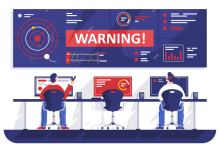
If you think customer relationship management (CRM) software can only play in the sales sandbox, think again. CRM provides a host of capabilities that help contact centers serve their customers in excellence, across media, while delivering a more satisfying experience for their agents and organizational peers. For example:
- • CRM provides access to key customer information at the start of each session. Everything agents need to launch discussions is provided conveniently on the main screen.
• Agents have ready access to each customer’s services, recent purchases and interaction history across a range media. This information helps them come up to speed quickly on each relationship.
• Knowledge management features help respond to frequently asked questions, identify internal resources or processes to handle varying transaction types, and/or comb the enterprise library to respond to specific customer needs.
• CRM solutions support scripting to guide contact handling and create opportunities to extend relationships.
• CRM workflows process interactions from end-to-end and make sure that nothing gets dropped along the way.
• Customer satisfaction tracking and reporting ties feedback to specific interactions and agents to pinpoint the source of favorable and unfavorable reviews.
• CRM boosts market intelligence by providing access to a wealth of data on customers’ interactions with the enterprise.
These capabilities reduce average handle time and bolster first contact resolution while promoting consistent treatment across agents and self-service channels. And, of course, they sweeten the bottom line!
Given ever-present resource constraints, some contact center leaders wonder if they couldn’t simply use their Customer Information System (CIS) to perform these functions, or build CRM functions into their CIS. Here are three reasons why that approach is not optimal:
- 1. Unlike their CRM counterparts, critical information about the customer from a contact center perspective can be spread across multiple CIS screens or tabs, making it awkward and time-consuming for agents to pull everything together in service of their customers’ needs. This arrangement is inefficient and ineffective.
2. Most CIS systems prove inadequate when it comes to interaction tracking. The workaround generally involves capturing a few details in the notes section. Notes are both optional and unstructured, making it difficult for anyone using them to gain a true sense of the relationship and history. And, of course, unstructured notes don’t lend themselves readily to reporting or analysis.
3. Homegrown systems often fall short of expectations and rely on two few individuals who don’t have time to meet evolving needs.
The good news is you don’t have to replace your CIS to gain the benefits of CRM. CIS could maintain the customer database while CRM records the transaction history and/or provides the agents’ user interface. CIS could perform selected functions long term, or as you phase in additional CRM capabilities, thereby mitigating risk and the challenges of organizational change.
If you decide to move forward, keep in mind that CRM is not a solution that should be evaluated, purchased, or implemented on a silo-by-silo basis. The real benefit comes from consolidating customer data and interaction history across all points of access throughout the organization. While CRM nirvana may not be attainable, it merits a substantive effort by all affected parties to get as close to it as possible.



